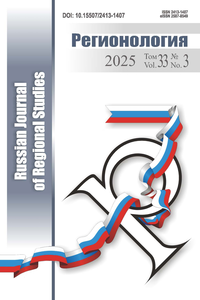M. V. Nazukina. Markers of Ethnicity in the Regional Identity of Russia’s Republics
UDK 316.347(470+571)
DOI: https://doi.org/10.15507/2413-1407.105.026.201804.698-717
Introduction. The ethnic component is one of the most important foundations for regionalization of the political space and construction of the region. The relevance of the study is due to the fact that it should determine the possibilities and conditions for consolidation of territorial communities within certain identification systems. The purpose of the research is to identify the markers showing the presence of ethnicity in the identity of the republics of the Russian Federation as an indicator of correlation between the ethnic and regional identities.
Materials and Methods. The study employed such sources of analysis as presentation materials and business cards of the republics of the Russian Federation, constitutions and regulations on regional symbols, language policies and programs managing interethnic relations as well as the development strategies of the republics. Discourse analysis and the method of in-depth expert interviews were also used.
Results. The study has revealed the basic identifiers of a region that comprise ethnicity. It has proved that ethnicity can be considered a resource for development of a territory as a unique feature of the regional community. The resource of ethnicity is associated with the positioning based on the idea that the status of the republics as ethno-territorial units differs from the status of other regions and therefore is capable of bringing certain benefits.
Discussion and Conclusion. The ethnic component is an important resource for positioning regional uniqueness of the community, including through cultivation of the idea of stability, diversity and peace in the republics. The identified markers can be used as indicators of the presence of ethnicity in the regional identity when conducting comparative studies. The practical effect is associated with the possibilities of using them when following the identity policy in the regions and that of harmonization of multiple identities.
Keywords: republic, ethnicity, regional identity, identity policy, regional symbol, language policy, positioning of a region
REFERENCES
1. Brubaker R., Cooper F. [Beyond “identity”]. Ab imperio. 2002; 3:61-115. Available at: https://elibrary.ru/item.asp?id=9082677 (accessed 08.06.2018). (In Russ.)
2. Nazukina M.V. Structural levels of regional identity in modern Russia. Regionologiya = Regionology. 2011; 4:12-18. Available at: http://regionsar.ru/ru/node/809 (accessed 08.06.2018). (In Russ.)
3. Keating M. [New regionalism in Western Europe]. Logos = Logos. 2002; 6:67-116. Available at: https://elibrary.ru/item.asp?id=27679628 (accessed 08.06.2018). (In Russ.)
4. Bourdieu P. [Identity and representation: Elements for a critical reflection on the idea of region]. Ab imperio. 2002; 3:45-61. Available at: https://elibrary.ru/item.asp?id=17958419 (accessed 08.06.2018). (In Russ.)
5. Paasi A. Region and place: regional identity in question. Progress in Human Geography. 2003; 27(4):475-485. DOI: https://doi.org/10.1191/0309132503ph439pr
6. Acharya A. Do norms and identity matter? Community and power in Southeast Asia’s regional order. The Pacific Review. 2005; 18(1):95-118. DOI: https://doi.org/10.1080/09512740500047199
7. Twigger-Ross C.L., Uzzell D. Place and identity processes. Journal of Environmental Psychology. 1996; 16(3):205-220. DOI: https://doi.org/10.1006/jevp.1996.0017
8. Turovsky R.F. [The burden of space as a political problem of Russia]. Logos = Logos. 2005; 2:124-171. Available at: http://www.ruthenia.ru/logos/number/46/05.pdf (accessed 08.06.2018). (In Russ.)
9. Zamyatina N.Yu. Cities, areas and countries in the political relief of Russian regions (With the materials of RF subjects’ official sites used). Polis. Politicheskie issledovaniya = Polis. Political Studies. 2006; 2:122-138. (In Russ.) DOI: https://doi.org/10.17976/jpps/2006.02.10
10. Zamyatina N.Yu. [Strategies for creating images of the constituent entities of the Russian Federation and regional ideology (“nationalist” context)]. Obshhestvennye nauki i sovremennost = Social Sciences and Contemporary World. 2006; 6:94-108. Available at: http://ecsocman.hse.ru/text/18489303/ (accessed 08.06.2018). (In Russ.)
11. Krylov M.P. [Russia’s regional identity as the focus of the socio-cultural situation (the case study of European Russia)]. Logos = Logos. 2005; 1:275-289. Available at: http://www.ruthenia.ru/logos/number/46/11.pdf (accessed 08.06.2018). (In Russ.)
12. Dolgaeva E.I. Interpretation of the factors of the all-Russian national and civil identity by the inhabitants of a multiethnic region. Regionologiya = Regionology. 2018; 26:123-140. (In Russ.) DOI: https://doi.org/10.15507/2413-1407.102.026.201801.123-140
13. Maklashova E.G., Astakhova I.S. Ethnicity and identity: Features of formation in conditions of ethnic Russian republic. Diskurs Pi = Discourse-P. 2014; 2:73-78. Available at: http://www.madipi.ru/index.php?option=com_content&view=article&id=201&It... (accessed 08.06.2018). (In Russ.)
14. Bogatova O.A., Chirkova O.N. Formation of the Republic of Mordovia ethnocultural image in the regional branding. Regionologiya = Regionology. 2013; 3:68-75. Available at: https://regionsar.ru/ru/node/1145 (accessed 05.06.2018). (In Russ.)
15. Tsvetkova O.V. Regional and ethnic identity as a factor of differentiation of the political space. Izvestiya Tulskogo gosudarstvennogo universiteta. Gumanitarnye nauki = Izvestiya Tula State University. Humanitarian sciences. 2017; 1:68-73. Available at: https://tidings.tsu.tula.ru/tidings/pdf/web/preview_therest_ru.php?x=tsu_izv_humanities_2017_001&year=2017 (accessed 08.06.2018). (In Russ.)
16. French S., Coleman B., DiLorenzo M. Linking racial identity, ethnic identity, and racial-ethnic socialization: A tale of three race-ethnicities. Identity; 2013; 13(1):1-45. DOI: https://doi.org/10.1080/15283488.2012.747438
17. Laclau E., Mouffe C. Hegemony and Socialist Strategy. Towards a Radical Democratic Politics. Second Edition / E. Laclau, C. Mouffe. London, New York, 2001. 198 p. Available at: https://www.researchgate.net/publication/200026738_Hegemony_and_Socialist_Strategy_Towards_A_Radical_Democratic_Politics (accessed 08.06.2018).
Submitted 26.06.2018; accepted for publication 02.08.2018; published online 28.12.2018.
About the author:
Mariya V. Nazukina, Research Officer, Department for Research of Political Institutions and Processes, Perm Federal Research Center, Ural Branch of the Russian Academy of Sciences (13a Lenin St., Perm 614990, Russia), Associate Professor, Department of Political Sciences, Perm State University (15 Bukirev St., Perm 614900, Russia), Ph. D. (Political Science), ORCID: http://orcid.org/0000-0003-0190-0513, Researcher ID: http://www.researcherid.com/rid/L-8246-2016, nazukina@mail.ru
For citation:
Nazukina M.V. Markers of Ethnicity in the Regional Identity of Russia’s Republics. Regionologiya = Regionology. 2018; 26(4):698-717. DOI: https://doi.org/10.15507/2413-1407.105.026.201804.698-717
The author has read and approved the final version of the manuscript.

All the materials of the "REGIONOLOGY" journal are available under Creative Commons «Attribution» 4.0
















